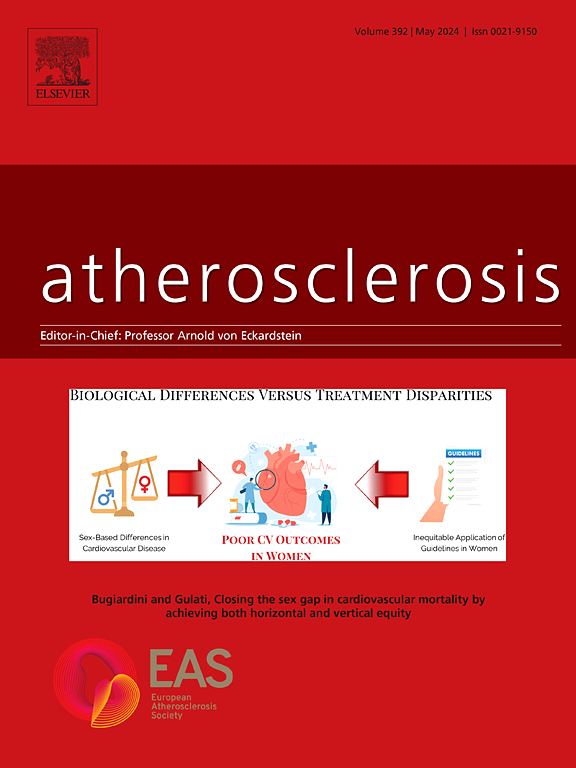Low-density lipoprotein-cholesterol subfractions as predictors for coronary artery calcium incidence and progression – The Brazilian longitudinal study of Adult Health (ELSA – Brasil)
IF 4.9
2区 医学
Q1 CARDIAC & CARDIOVASCULAR SYSTEMS
引用次数: 0
Abstract
Background and aims
Low-density lipoprotein-cholesterol (LDL-c) subfractions may play different roles in atherogenesis. Our objective was to evaluate the association between LDL-c subfractions and coronary artery calcium (CAC) incidence in individuals with a baseline CAC = 0 and CAC progression in those with CAC > 0 at baseline.
Methods
We include 2632 participants from the Brazilian Longitudinal Study of Adult Health cohort, all of whom underwent two repeated CAC score measurements and had LDL-c subfraction measurements. The LDL-c subfraction concentrations were measured by the vertical auto profile method and categorized as small dense LDL-c (sdLDL-c) and large buoyant LDL-c (lbLDL-c). We constructed logistic regression analyses to examine CAC incidence and CAC progression. Additionally, CAC progression was analyzed using linear regression analyses as continuous variables.
Results
At baseline, a total of 2066 individuals (47.2 years, 62.2% female) had CAC = 0 and 566 (53.63 years, 36.9% female) had CAC > 0. The mean interscan interval was (5.15 ± 2.37 years). We found a significant association between sdLDL-c and CAC incidence (OR, 1.29 [95% CI, 1.13–1.47]) but not for lbLDL-c (p = 0.28) after adjustment for confounders. We found no association of the sdLDL-c fraction with CAC progression in any of the analyses. However, lbLDL-c concentrations were inversely associated with CAC progression on both logistic and linear regression analyses (all p < 0.05).
Conclusion
There is a positive association between incidence of CAC and sdLDL-c but not lbLDL-c. CAC progression was inversely associated with lbLDL-c but not with sdLDL-c.

低密度脂蛋白-胆固醇亚组分作为冠状动脉钙化发病率和进展的预测因子——巴西成人健康纵向研究(ELSA - Brasil)
背景和目的:密度脂蛋白-胆固醇(LDL-c)亚组分可能在动脉粥样硬化中起不同的作用。我们的目的是评估基线CAC = 0的个体LDL-c亚段与冠状动脉钙(CAC)发病率和CAC进展之间的关系;基线为0。方法:我们纳入了来自巴西成人健康纵向研究队列的2632名参与者,所有参与者都进行了两次重复的CAC评分测量和LDL-c亚分数测量。采用垂直自动剖面法测定LDL-c亚组分浓度,并将其分为小密度LDL-c (sdLDL-c)和大浮力LDL-c (lbLDL-c)。我们构建了逻辑回归分析来检验CAC发病率和CAC进展。此外,使用线性回归分析作为连续变量分析CAC进展。结果基线时,共有2066例(47.2岁,女性62.2%)CAC = 0, 566例(53.63岁,女性36.9%)CAC = 0;0. 平均间隔时间为(5.15±2.37年)。校正混杂因素后,我们发现sdLDL-c与CAC发病率之间存在显著相关性(OR, 1.29 [95% CI, 1.13-1.47]),但与lbLDL-c无关(p = 0.28)。在任何分析中,我们都没有发现sdLDL-c分数与CAC进展的关联。然而,在logistic和线性回归分析中,lbLDL-c浓度与CAC进展呈负相关(所有p <;0.05)。结论CAC与sdLDL-c呈正相关,与lbLDL-c无显著相关性。CAC进展与lbLDL-c呈负相关,但与sdLDL-c无关。
本文章由计算机程序翻译,如有差异,请以英文原文为准。
求助全文
约1分钟内获得全文
求助全文
来源期刊

Atherosclerosis
医学-外周血管病
CiteScore
9.80
自引率
3.80%
发文量
1269
审稿时长
36 days
期刊介绍:
Atherosclerosis has an open access mirror journal Atherosclerosis: X, sharing the same aims and scope, editorial team, submission system and rigorous peer review.
Atherosclerosis brings together, from all sources, papers concerned with investigation on atherosclerosis, its risk factors and clinical manifestations. Atherosclerosis covers basic and translational, clinical and population research approaches to arterial and vascular biology and disease, as well as their risk factors including: disturbances of lipid and lipoprotein metabolism, diabetes and hypertension, thrombosis, and inflammation. The Editors are interested in original or review papers dealing with the pathogenesis, environmental, genetic and epigenetic basis, diagnosis or treatment of atherosclerosis and related diseases as well as their risk factors.
 求助内容:
求助内容: 应助结果提醒方式:
应助结果提醒方式:


